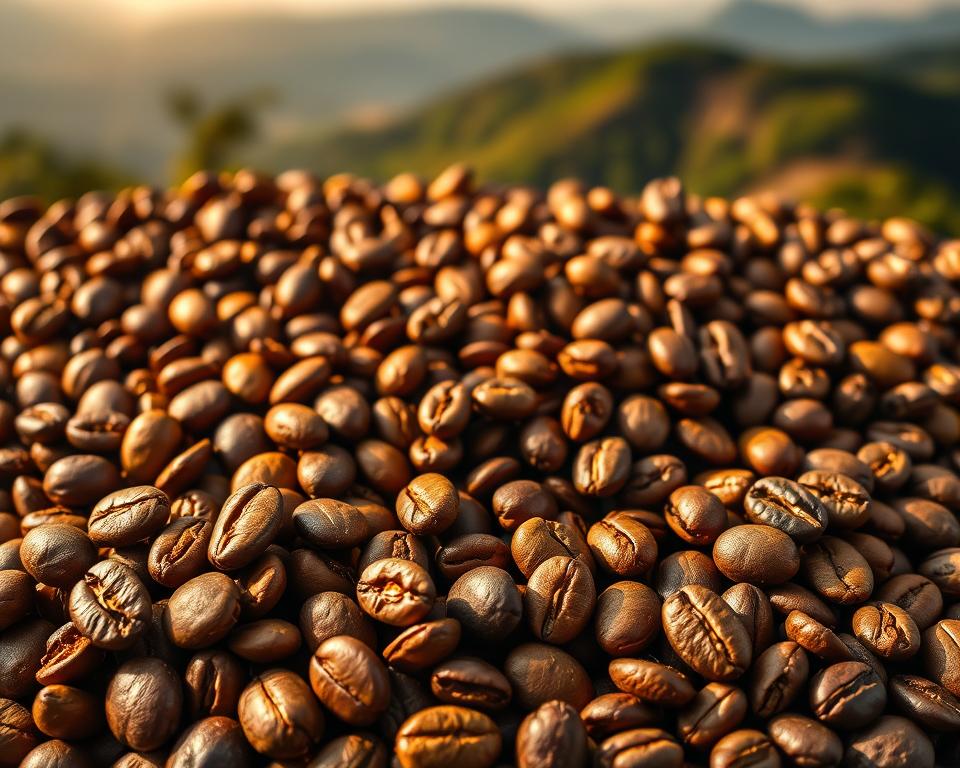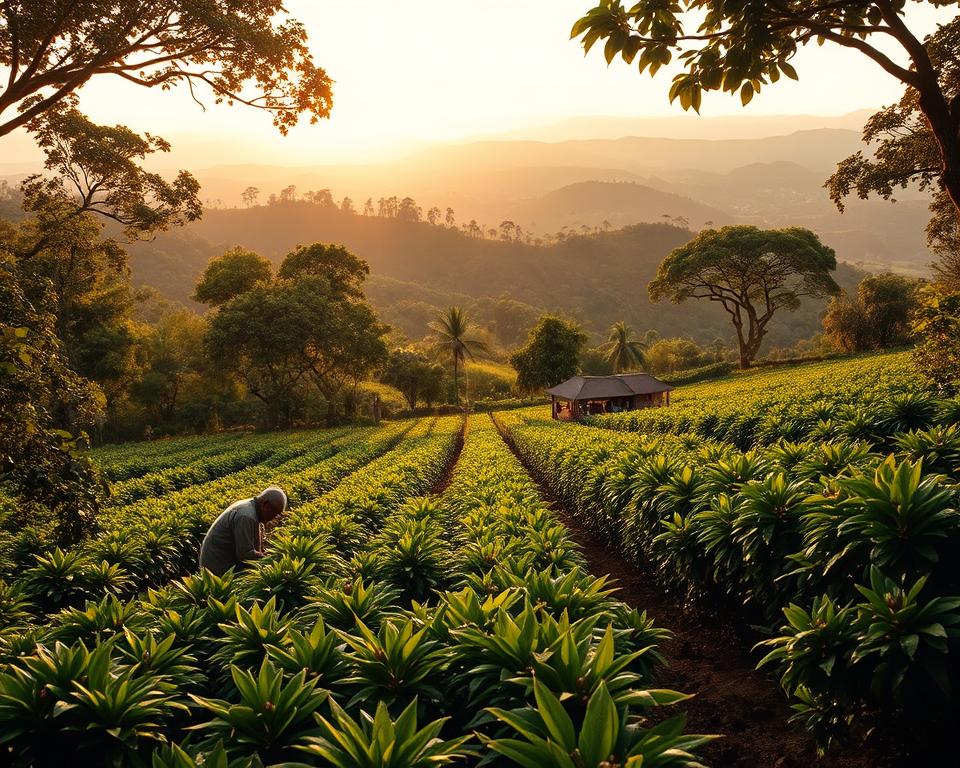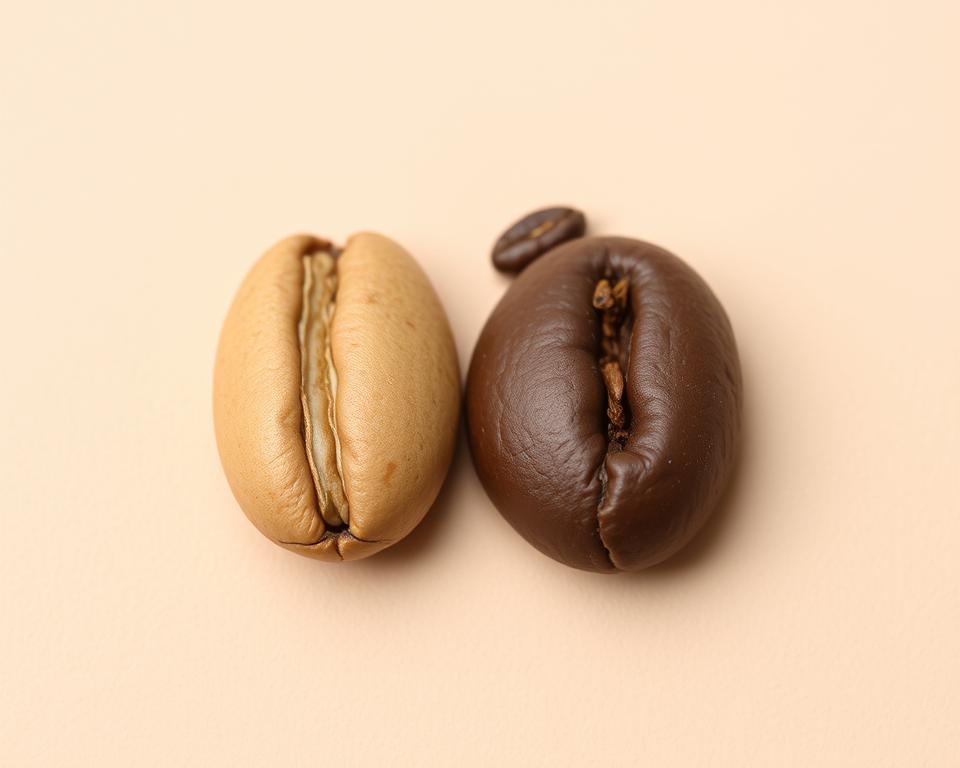Coffee varieties like Arabica and Robusta shape the taste and quality of every cup. These two types lead the global market, with Arabica making up 70% and Robusta 30%. Each type offers a unique experience—Arabica’s sweet notes contrast with Robusta’s bold bitterness. For a deeper dive, explore Lavazza’s guide to learn how growing conditions and chemistry influence each bean.
Key Takeaways
- Arabica beans hold 1.5% caffeine, while Robusta packs up to 2.7%, nearly double the caffeine kick.
- Arabica thrives at elevations over 3,000 feet, whereas Robusta grows in varied climates from subtropical to tropical zones.
- Arabica’s ovular beans feature curved splits, while Robusta’s beans are rounder with straighter splits.
- Robusta’s lower lipid and sugar levels (60% less than Arabica) create its stronger, less sweet profile.
- Arabica’s premium price stems from delicate growing needs, while Robusta’s hardiness makes it cheaper on commodity markets.
Introduction to Coffee Varieties
Coffee is more than a morning boost; it’s a vast world of diversity. With over 129 species in the Coffea genus, each variety boasts unique flavors and histories. Arabica and Robusta make up 95% of global production, but exploring lesser-known types uncovers surprising tastes and stories. From Ethiopia’s 10,000+ distinct varieties to the record-breaking $803-per-pound Gesha, every bean has a story to tell. This knowledge bridges the gap between farm and cup.
What Are Coffee Varieties?
Coffee varieties, like grape varietals in wine, are distinct genetic types within the Coffea genus. Typica, Bourbon, and SL28 are examples shaped by centuries of natural mutations and human cultivation. Specialty coffee blends often highlight single-origin beans, such as the floral Gesha or the citrus-forward Bourbon. These differences come from genetic traits, growing conditions, and processing methods, creating the vast flavor spectrum in your cup.
Importance of Understanding Coffee Types
Choosing the right variety is crucial. Popular coffee beans like Caturra or Pacamara offer distinct profiles, while specialty coffee blends highlight unique origins. Knowing varieties helps decode price tags, trace sustainability efforts, and match beans to brewing methods. Whether you’re sipping a Kenya AA or a Colombian Supremo, variety choices shape every sip.
The Two Main Types: Arabica and Robusta
Coffee varieties shape the global market, each with unique coffee origins and distinct traits. These two beans define flavor, culture, and production across continents.
Arabica: The Elegance of Specialty Coffee
Arabica beans originated in Ethiopia’s high-altitude forests, dating back to the 12th century. They grow best at 3,000+ feet, developing floral, fruity, or citrus notes. Their ovular shape and curved split line reflect their delicate growing conditions.
- Caffeine: 1.5% – half of Robusta’s 2.7%.
- Harvest: Hand-picked due to uneven ripening clusters.
- Profile: 60-70% of global production, prized for specialty brews.
Robusta: The Versatile Workhorse
Rising from sub-Saharan Africa, Robusta thrives in varied climates, from tropical lowlands to diverse terrains. Its rounder beans and straight split line hint at its rugged nature.
- Caffeine: Double Arabica’s content at 2.7%, powering its bold body.
- Harvest: Uniform clusters allow mechanical picking, lowering costs.
- Role: 30-40% of global supply, used in espresso blends and instant coffee.
From Ethiopia’s highlands to Vietnam’s plantations, their unique coffee origins drive taste and tradition. Each bean’s journey from soil to cup tells a story of adaptation and demand.
Flavor Profiles of Arabica and Robusta
Delving into the realm of diverse coffee flavors begins with recognizing the distinctiveness of Arabica and Robusta. Arabica beans exhibit a range of tastes, influenced by their surroundings and processing methods. Varieties such as Colombian Supremo and Ethiopian Yirgacheffe are renowned for their floral or berry-like nuances. In contrast, Robusta’s robustness is a key component in blends, enhancing the espresso’s depth. Let’s dissect their unique characteristics:
Taste Characteristics of Arabica
Arabica’s mild profile is distinguished by its sweet, fruity, or caramel notes. These beans often exhibit higher acidity, akin to citrus or tea-like brightness, alongside low bitterness. Their lipid and sugar content contribute to a smoother drinking experience, appealing to aficionados of specialty coffee. For an exploration of the finest blends that combine these attributes, refer to this guide.
Taste Characteristics of Robusta
Robusta offers a heavier body with earthy, woody, or nutty undertones. Its higher caffeine content amplifies bitterness, making it a crucial component in espresso blends for its rich crema. Despite its robust profile, premium Robusta varieties like Vietnamese Chari or Congee have the potential to rival Arabica in quality when sourced sustainably.
| Aspect | Arabica | Robusta |
|---|---|---|
| Flavor Intensity | Mild, complex | Bold, robust |
| Acidity | High (citrus, tea-like) | Low (chocolate, nuts) |
| Bitterness | Low | High |
| Top Examples | Kenyan AA, Jamaican Blue Mountain | Nganda, Congo |
Processing methods like washed or natural further refine these flavors. While Arabica dominates the specialty market, Robusta’s resilience makes it a cost-effective option for blends. Both offer distinct experiences—venture into them to discover your ideal brew!
Growing Conditions for Coffee Varieties
Where coffee plants grow influences their taste and destiny. Coffee varieties flourish in particular climates, giving rise to unique coffee origins that shape global markets. These environmental needs explain why certain areas are known for specific types.
Ideal Conditions for Arabica
- Grow best above 3,000 feet, often shaded under trees.
- Need mild temperatures (60-75°F) and consistent rainfall.
- Volcanic soils in Ethiopia, Colombia, and Costa Rica fuel premium crops.
Ideal Conditions for Robusta
- Flourish at lower altitudes (below 2,500 feet) in hotter climates.
- Resists pests like coffee berry borers and leaf rust.
- Common in Vietnam’s lowland plantations and Brazilian sun-drenched farms.
The future of coffee depends on these conditions. Rising temperatures threaten Arabica’s highland habitats, pushing farms uphill. Ethiopia alone safeguards over 10,000 distinct coffee varieties, but climate shifts could erase centuries of genetic diversity. Farmers in Kenya’s highlands already face shifts, with optimal growing zones climbing 1,000+ feet. Such changes redefine unique coffee origins, urging innovations like shade-grown methods or heat-resistant hybrids. The story of coffee isn’t just in the cup—it’s rooted in the soil, weather, and farmers’ choices.
Health Benefits of Coffee
Whether you prefer the mild acidity of Arabica or the boldness of Robusta, different types of coffee offer unique health perks. Both varieties contain antioxidants and compounds that may boost well-being, but their benefits differ. Let’s explore how they compare and how best coffee roasts can enhance these advantages.
Arabica’s Health Edge
- Lower caffeine (1.5%) means gentler stimulation, ideal for those sensitive to jittery effects.
- Rich in antioxidants like chlorogenic acids, which may reduce inflammation and support heart health.
- Linked to a 15% lower risk of heart disease and a 21% reduced stroke risk.
Robusta’s Bold Benefits
- Higher caffeine (2.7%) boosts alertness and endurance—studies show a 12% increase in cycling performance.
- Higher chlorogenic acid levels may improve blood sugar control, reducing type 2 diabetes risk by 6% per cup.
- Associated with a 71% lower risk of liver disease and antimicrobial properties.
| Aspect | Arabica | Robusta |
|---|---|---|
| Caffeine Content | 1.5% | 2.7% |
| Antioxidants | Moderate chlorogenic acids | Higher antioxidant concentration |
| Key Benefit Focus | Heart health, mild energy | Endurance, metabolic support |
Roast Levels Matter Too
Light roasts preserve more caffeine and original bean flavors, while dark roasts reduce acidity but may lower some antioxidants. For maximum antioxidants, opt for light or medium best coffee roasts. Dark roasts still shine—studies show they reduce DNA damage linked to cancer risks.
In 2016, the World Health Organization confirmed coffee isn’t a carcinogen and noted it may lower risks of liver and uterine cancers.
Whether you choose Arabica’s smoothness or Robusta’s kick, moderate intake (3-5 cups daily) aligns with Dietary Guidelines for Americans. Always consider personal tolerance and health goals when selecting your brew!
Popular Coffee Varieties Around the World
Exploring beyond Arabica and Robusta reveals a world of specialty popular coffee beans. These top coffee cultivars bring unique tastes and stories. From Ethiopian heirlooms to resilient hybrids, each variety has its own tale.

Arabica’s Hidden Gems
Ethiopia alone has over 10,000 native Arabica varieties. Among these, Bourbon beans are known for their floral acidity. Gesha is prized for its jasmine-like notes. The SL28 from Kenya offers blackcurrant and citrus flavors.
Caturra, a compact Bourbon mutation, balances quality with productivity. These varieties lead the specialty market.
Robusta’s Rising Stars
Robusta is more than just instant coffee. India’s Kaapi Royale has chocolate and spice tones. Uganda’s Kisinga surprises with wine-like acidity.
The Catimor hybrid combines Robusta’s hardiness with Arabica-like aroma. Even Liberica, with its smoky nuances, is gaining attention in the Philippines and Malaysia.
| Cultivar | Type | Flavor Notes | Origin |
|---|---|---|---|
| Gesha | Arabica | Jasmine, bergamot | Panama/Ethiopia |
| SL28 | Arabica | Blackcurrant, tea-like | Kenya |
| Kaapi Royale | Robusta | Chocolate, caramel | India |
| Caturra | Arabica | Berry, citrus | Latin America |
These varieties reflect centuries of adaptation. From Ruiru 11 (disease-resistant but lower-scoring) to Charrier (a caffeine-free Cameroon native), each has a story. For growers and drinkers, discovering these gems supports biodiversity and flavor innovation.
Coffee Varieties and Brewing Methods
Unlock the full potential of Arabica and Robusta beans with the right brewing methods. From pour-over setups to espresso machines, each technique highlights unique flavors. Let’s explore how to match your beans to the perfect brew.
Best Brewing Techniques for Arabica
Arabica’s nuanced flavors thrive with methods that emphasize clarity and acidity. Try these approaches:
- Pour-over (Chemex, Hario V6): Use light to medium best coffee roasts. Grind like table salt. Brew at 195–205°F for floral and fruity notes.
- Cold brew: Extend steep time to 12–24 hours to enhance sweetness in delicate beans.
- AeroPress: Ideal for travel. Fine-to medium grinds bring out citrus or berry undertones.
Best Brewing Techniques for Robusta
Robusta’s bold character shines with methods that amplify body and strength. Consider:
- Espresso: Blends with 10–20% Robusta create rich crema. Use darker roasts for smoother bitterness.
- French press: Coarse grinds and 4–5 minute steeping time highlight nutty flavors.
- Moka pot: High pressure extraction pairs well with robusta’s higher caffeine content.
Pro tip: Specialty coffee blends often mix Arabica and Robusta for balance. Adjust grind size and water temperature to match your beans’ origin and roast level. Always use fresh water and clean equipment for consistent results.
Sustainable Coffee Farming Practices
Sustainable practices protect the environments where unique coffee origins thrive, ensuring diverse coffee flavors remain vibrant for future generations. Shade-grown systems and organic methods are reshaping how Arabica and Robusta are cultivated to combat climate threats.

Importance of Sustainability in Coffee Production
Climate change threatens traditional growing regions, making sustainable farming crucial. It prevents deforestation and water pollution. Shade trees reduce pesticides, while organic practices boost soil health. These methods enhance bean quality, preserving the distinct profiles of regions like Colombia’s Arabica or Vietnam’s Robusta.
How Arabica and Robusta Plants Are Affected
Arabica’s sensitivity demands shade and organic care to maintain its delicate flavors. Robusta’s hardiness makes it adapt better to harsher conditions, but sustainable agroforestry still improves its resilience and taste. Here’s how practices impact each variety:
| Practice | Arabica | Robusta |
|---|---|---|
| Shade-Growing | Essential for flavor consistency | Reduces heat stress in hotter climates |
| Organic Methods | Preserves nuanced flavors | Cuts chemical use while maintaining robust yields |
| Agroforestry | Protects fragile ecosystems | Enhance soil stability in marginal lands |
Programs like Nespresso’s AAA and Starbucks’ C.A.F.E. Practices help farmers adopt these methods. Sustainable farming isn’t just eco-friendly—it’s about safeguarding the unique stories behind each bean. By choosing certified coffee, consumers help preserve both taste and tradition.
- Shade-grown farms boost biodiversity, improving bean complexity.
- Agroforestry systems increase farmer income through fruit and timber crops.
- Fair Trade programs ensure farmers earn fairly for their efforts.
Every sip of sustainable coffee supports thriving ecosystems and the people behind your morning brew.
Conclusion: Choosing the Right Coffee Variety for You
When picking your next coffee, think about what you like. Arabica offers a delicate acidity, while Robusta packs a bold punch. Specialty blends mix these, catering to all tastes.
Summary of Key Differences
Arabica beans are the majority, making up over 60% of coffee worldwide. They have mild flavors and less caffeine, appealing to those who enjoy floral or fruity notes. Robusta, with more caffeine, brings a strong earthy taste, often found in espresso.
Price and origin also play a role. Arabica grows best at high altitudes, while Robusta thrives in lower regions like Vietnam and Brazil. Brazil alone supplies 40% of the world’s coffee.
Final Thoughts on Coffee Varieties
There’s no single best coffee for everyone. Whether you prefer specialty blends or single-origin Arabica, try different types. Robusta’s boldness and rare varieties like Gesha from Ethiopia are worth exploring.
Coffee’s vast range, from Liberica’s smoky notes to Excelsa’s tartness, encourages discovery. Quality is key: choose ethically sourced beans and brewing methods that enhance each variety’s unique qualities. Your ideal coffee awaits, based on your taste preferences.
FAQ
What are the main differences between Arabica and Robusta coffee?
Why is it important to understand different coffee varieties?
What are the health benefits associated with coffee?
How do brewing methods affect the flavor of different coffee varieties?
What are some popular coffee bean varieties?
How does climate change affect coffee production?
Can coffee quality vary based on its origin?
What is the significance of sustainable coffee farming practices?

Tina Avila is a writer at WyNeeds, where she delves into the rich and diverse world of coffee. With a passion for flavors and brewing techniques, she brings insightful articles covering everything from coffee culture and bean origins to expert tips on making the perfect cup. Her goal is to inspire and educate coffee enthusiasts, helping them enhance their appreciation for every sip.

